The times of striking salary differences between jobs at sea on merchant vessels and offshore fleet are long gone. Nevertheless, a career in offshore remains quite appealing as wages are still decent and the duration of contracts rarely goes beyond 4 months. This is a powerful incentive, indeed; so many seafarers strive to make a move to the oil and gas industry.
Therefore, we’ve decided to explore offshore fleet jobs and scrutinize every type of offshore vessel from the most popular to the exotic ones. If you are interested in the money side, please read our Salary Gap Between Nationalities article.
Accommodation Barge and Accommodation Ship
Anchor Handling Tug Supply Vessel (AHTS)
FPSO (Floating Production Storage and Offloading)
Multi Role Support or Supply Vessels (MRSV)
Offshore Construction Vessel (OCV)
Seismic Vessels or Survey Ships
Wind Farm Installation Vessels (WIV)
Accommodation Barge and Accommodation Ship
Accommodation Barges are inalienable parts of the offshore industry. These are shallow draft vessels which are moored next to the offshore sites to provide additional accommodation facilities whenever a rig or platform is incapable of fitting all the offshore personnel.

Today these barges are usually equipped with cranes and maintenance equipment so as to perform some offshore construction work as well. But it’s not all work and no play; modern AWBs might be fitted with a bar, cinema, gym, conference rooms and lobby for meetings as well as a swimming pool.
Anchor Handling Tug Supply Vessel (AHTS)
Anchor Handling Tug Supply Vessel (AHTS) is another ship that can be found at any drilling site. AHTS vessel is truly universal as it combines a number of functions: tows rigs and platforms; anchors and moors mobile structures into the position at the site and supplies them subsequently. Big ships are capable of working in deep waters, for instance in Brazil or the Arctic region.
AHTS ships are defined by the required bollard pull, so they have a very distinct design with a big propeller, hull shape that provides the maximum immersion and stability as well as a range of specific deck equipment such as winch, stern roller, etc. However, their most distinctive features are powerful engines with BHP reaching 12240 and more (to compare 25 000 DWT Bulk Carrier will be fitted with a far less powerful main engine of approx. 6946 BHP).

There are usually up to 20 seafarers onboard AHTS vessels. Meanwhile, the crew of AHT ships might be smaller. Anchor Handling Tugs (AHT) are very similar to AHTS and perform the same role, but tend to be smaller and less technologically advanced.
Cable Laying Vessel
Offshore industry doesn’t revolve around oil and gas alone; and Cable Laying Vessels are the best proof of this statement. They are designed for the specific purpose of laying underwater cable networks.
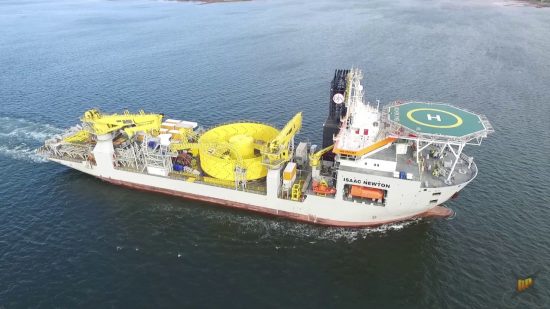
Imagine the level of our dependence on this kind of communication that it proves to be economically sound to build huge vessels devoted to the sole purpose of cables’ installation.
To ensure the maximum efficiency Cable Layers usually can lay the main and auxiliary umbilicals simultaneously. In addition, they are equipped with a profound DP system and both hydraulic and pneumatic cable laying systems.
Crew Boat
Crew Boats are the offshore vessels that are used for transportation of personnel and consumables (water, fuel) when the offshore site is situated within the 200 nautical miles (370 km) distance.
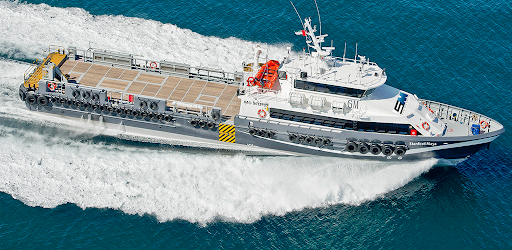
These vessels can differ in size from 30-to-60 ft (9.1 to 18.3 m) to big 200 ft (61m) ships that can transport up to 100 marine specialists. Usually, crew boats are fast (pick up a speed of approx. 33 knots) and have a crew of 4 – 5 seafarers.
The largest crew boat in the world today is catamaran Muslim Magomaev built in 2015. It boasts an overall length of 70 m and travels at a maximum speed of 38 knots.
Diving Support Vessel (DSV)
Today DSVs tend to be one of the most sophisticated offshore vessels. Their role is to provide a base for diving specialists who conduct underwater maintenance or inspections of mobile platforms, rigs, pipelines and their connections, well-heads, etc.
Therefore, DSV is usually fitted with a moonpool (open area in the middle of the vessel where divers’ and ROV’s operations start their operation) and recompression chamber. In addition, Diving Support Vessels always are provided with a DP3 class positioning system due to safety requirements.
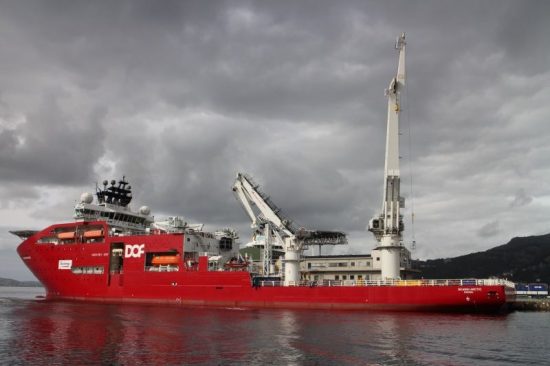
Scandi Arctic is reputedly the most technologically advanced DSV these days. She is a saturation dive support vessel equipped with the 24-man diving complex with Hyperbaric Monitoring and Control System.
Saturation diving is used for the most challenging and hard-to-reach offshore jobs requiring to create the pressurised environment filled with oxygen-helium mixture where divers live for the entire contract.
Diving support requires navigational perfection, so Scandi Arctic is DP3 class vessel; and is fitted with advanced National oilwell crane 400t-15m with wire capacity 2000 m to be able to perform some Inspection, Repair and Maintenance (IRM) operations.
Drilling Platform
People drill for oil from the submerged wells from the end of the 19th century. The first such production started in the Grand Lake St. Marys in Ohio in 1891, but the offshore drilling in the form we know (deep wells, semi-submersibles and self-sufficient drilling platforms started only in the mid-20th century).
Jack up rigs emerged in 1954 with the need to drill on the depth more than 30 meters (98ft); while semi-submersible platform was invented by accident in 1961.
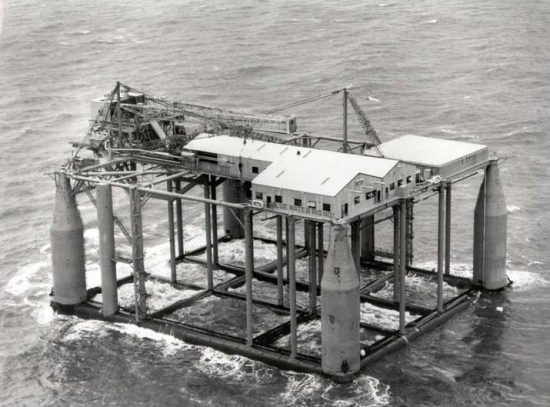
Shell had a submersible four-column drilling rig called Blue Water Rig No.1 in the Gulf of Mexico, but its construction was deficient and the pontoons failed to support the weight of the rig sufficiently. Therefore, the rig was towed at a draught midway between the deck and the pontoons. It was noticed that the motions of this draught is very small and it’s more reasonable to operate the rig in this floating mode.
Since that time six generations of semi-submersibles have been developed each generation able to drill in deeper waters. At present the 6th generation operates in waters deeper than 3000 m.
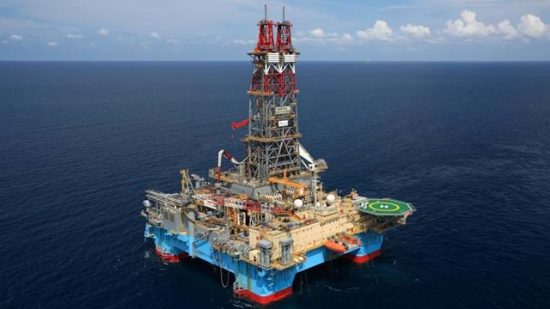
Semi-submersibles use Dynamic Positioning to stay above the well; and anchors in shallower waters; they usually are connected to the ocean floor by umbilicals as fixed structures are not practical in such depths. Whereas fixed drilling platforms operate in less deep waters and are fixed to the shelf.
The largest oil rig in the world is Berkut. It was built to develop the plentiful Arkutun-Dagi oilfield in Okhotsk Sea. The giant weighs unimaginable 200 000 t and is constructed on a gravity-based structure (GBS) fixed to the seabed at a depth of 35 metres. It is estimated that 52,000m³ of concrete and 27,000 tons of steel reinforcing bars were used to build the legs. As a result, Berkut can withstand the ice pressure, 18 m waves and even a magnitude 9 earthquake. Read more in our Offshore Giants article.
FPSO (Floating Production Storage and Offloading)
An FPSO is a floating unit used in the oil and gas industry for production and storage of hydrocarbons. FPSO are usually chosen for the oil abundant areas located away from the developed pipeline infrastructure.
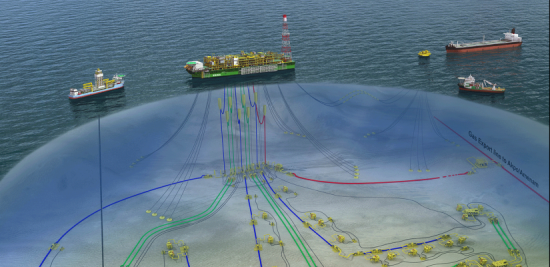
FPSO job is to produce, process and store oil itself; alternatively, she collects it from the subsea template or nearby rig. The risers that come from the seabed are connected to the special mechanism (turret). The vessel is able to rotate around it to ensure safety or even disconnect temporarily from the subsea infrastructure and sail away to escape severe weather.
The first FPSO to obtain such a unique capability was Shell’s Turritella. She is stationed in the Stones oilfield in the Gulf of Mexico and is the deepest FPSO in the world operating in a water depth of 2,900 meters (9,500 feet) making her the world’s deepest Oil & Gas production unit of any kind as well.
The world’s largest FPSO is Egina built for the remote Nigerian same-name oil field. She is 330 m long while her storage capacity reaches 2.3 million barrels of oil. We described Egina’s dubious fate in the Offshore Giants: the Largest Oil and Gas Units article.
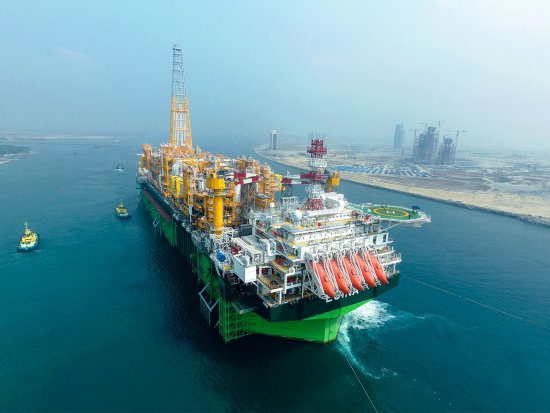
Incidentally, floating units used exclusively for storage of hydrocarbons are called FSO; and usually these are refurbished Supertankers.
Jack Up Rig
Jack Up drilling platform is rightly considered to be one the most convenient Mobile Offshore Drilling Unit (MODU) in the industry. The era of jack ups has started back in 1954 when Leon B. DeLong in cooperation with McDermott developed the first mobile unit for Humble Oil. It was called DeLong-McDermott No.1 and had 10 legs with spud cans.
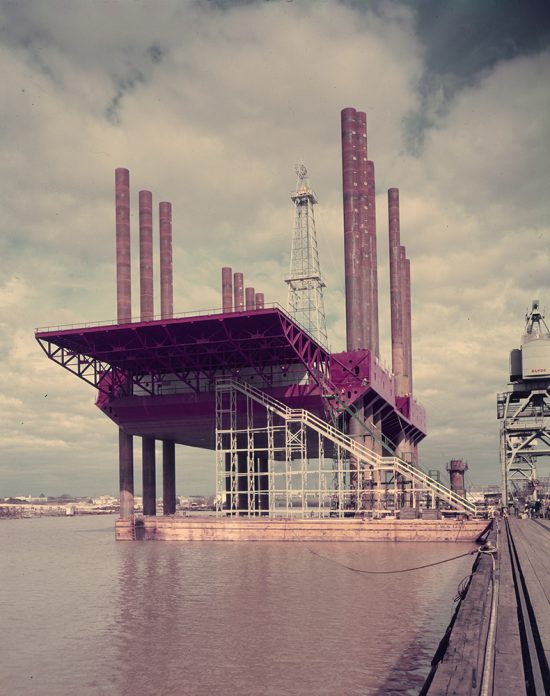
Jack ups have been refined into technological masterpieces since that time. Now they are easy to transport (usually by AHTS or Heavy-Lifts), but there are also self-propelled rigs. They are more stable than semi-submersibles and cheaper than FPSO or drillships. However, its advantages impose certain limitations, i.e. jack up can drill up to the water depth of 107 m (350 ft) only.
Jack Ups differ by the number of characteristics:
- Number of legs (there can be either 3 or 4 ones);
- Legs designs: open-truss legs which are made of crisscrossed tubular steel sections and columnar legs made of immense steel tubes. The latter are cheaper to produce, but can be used up to 76 m (250 ft) water depth because they prove to be less durable.
- Leg support: there can be a mat support that connects all legs and independent-legged rigs with spud like support.
- Drilling device design: the most popular are cantilevered jackups where drilling derrick is mounted on the arm placed out of the drilling deck. The other option is the slot-type jackup. These types have the drilling equipment in the special slot in the drilling deck.
Multi Role Support or Supply Vessels (MRSV)
MRSVs are incredibly popular among offshore shipowners. These are big vessels (usually about DWT 4500) equipped with various servicing equipment such as knuckle boom cranes, ROVs, diving units and so on.
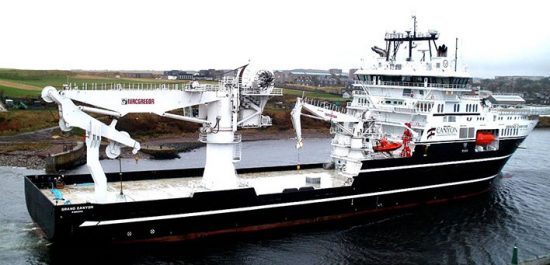
MRSV are capable of offshore construction, ROV and diving support, so usually furnished with DP 2 or DP 3 systems, thrusters and advanced navigational equipment as well as helideck.
Probably the best example of the Multi Role Support Vessel is DP3 Grand Canyon II which is equipped for all the abovementioned offshore jobs.
https://www.youtube.com/watch?v=AJDj-B7inaQ
Offshore Construction Vessel
Offshore Construction Vessels (OCV) are huge and technologically advanced vessels used for deep sea and subsea construction or vice versa decommissioning of offshore structures. For instance, OCV might be contracted to build a wind farm, oil platform, take part in a pipe laying project or dismantle a drilling rig.
As a rule, these are DP vessels with heavy-duty cranes, pipe-laying, ROV and other essential offshore modules. The largest Offshore Construction Vessel today proves to be the Allseas’ Pioneering Spirit built in 2016. She is a gigantic catamaran measuring 382 metres in length and 124 metres in width which is the size of 6 football pitches; while her cranes can cover the distance of the 8 football fields.
The gap between two hulls reaches 122 metres by 59 metres and accommodates another vessel, barge ‘Iron Lady’. Moreover, Pioneering Spirit is able to work as a floatel as it hosts 560 crew members and offshore specialists. At present, she works in the Danich sector of the North Sea in Tyra field recycling drilling rigs there on behalf of Total.
Pipe Laying Vessel
Pipe-laying vessels are among the largest offshore ships. They are used for the installation of the marine pipeline infrastructure for instance from drilling provinces to onshore refineries and so on.
https://www.youtube.com/watch?v=bPk4a_suJ80
Pipelayers usually accommodate an extensive crew of above 100 crew members. There are usually high requirements for the crew as the vessel works in DP mode constantly and is equipped with a heavy-duty crane and sophisticated mechanisms such as ‘S-laying’ or ‘J-laying’ pipe laying equipment.
- The term ‘S-laying’ derives from the shape of the arc piping taken when it’s let up from the vessel to be put in the water. The position of the mechanism aboard the vessel laying out the pipes is completely flat which allows the pipes to take the unique S-shaped curve.
- The ‘J-laying’ pipe laying mechanism is positioned perpendicularly; that enables it to control the curve of the pipe as it is lowered into the required depths of the water and provides the J-shaped curve.
- There is also the technology when the entire pipeline is installed using buoys and tugs; once the pipeline is built and the desired spot reached the buoys are removed and pipeline submerges.
Platform Supply Vessel (PSV)
Probably the most popular type of offshore vessels. Platform Supply Vessels (PSV) are used to deliver stores, necessary equipment and drilling consumables from shore bases to the drilling platform.
PSV are designed to have bridge structures in the front and vast cargo areas on the deck. There are also double-hull tanks for liquid cargo (drill mud, methanol, chemicals) and dry cargo that are transported in the special tank on the aft open deck.
Typical PSV ranges from 50 to 100 m in length; it usually spends about 25% of its operational time loading, most of the time (about 40%) sailing to rig or platform at 14 -16 knots and the rest of the operational time is occupied by discharging often in drastic conditions. That is why Platform Supply Vessels are equipped with DP1 or DP2 systems.
PSV jobs are versatile and paid differently depending on the vessel and conditions. The number of crew members can reach 36 seamen.
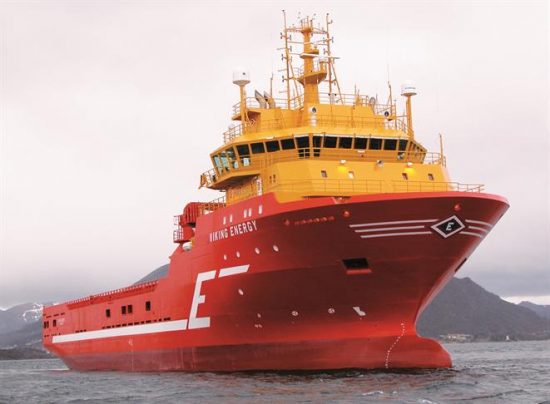
Similar to other industries, offshore vessels switch to a green propulsion. The Viking Energy has become the first LNG-fuelled PSV in the world. She was built in Gdańsk (Poland) and later towed to Kleven Verft (Ulsteinvik, Norway) for outfitting.
PSV Viking Energy is not only big (the overall length of is almost 95 m), but a very safe vessel. There is a special reservoir reminiscent of “thermos flask” in the middle of the vessel that guards the LNG fuel against insidious North seas.
ROV Support Vessels
Today ROV Support Vessels are the highly sophisticated offshore ships equipped for various ROV operations. A remotely operated vehicle (ROV) is an unmanned underwater vehicle connected to the ship through wires and computer-controlled. ROVs are used for hydrographic researches, underwater inspections (hulls, pipelines, etc.), marine archeology and a lot more.
Therefore, ROV Support vessels usually are fitted with more advanced DP systems, thrusters and reference systems to ensure redundancy and full control over ROV operations.
Incidentally, the first ROV, the machine called Poodle, was created back in 1953 by Dimitri Rebikoff, but it wasn’t until the US Navy started to use remotely operated vehicles for the recovery of the lost sunken torpedos that the ROV technology had gained a wide acknowledgement.
Seismic Vessels or Survey Ships
Offshore vessels dedicated for geological research.These ships are equipped with special transmitters which fire sound waves into the bottom of the sea. The echo of the shot is captured and analyzed by the special buoys/ hydrophones towed behind the vessel.
The deck is usually crammed with winches and storage reels. Another special feature of survey vessels is minimal propeller noize and precise station keeping to avoid interference with the survey equipment.
Seismic vessels are used in oil and gas exploration as well as a wide range of scientific research. Incidentally, the first research vessel is Capt. Cook’s HM Bark Endeavour which departed from Plymouth in August 1768 for its terra incognita expedition to Australia and New Zealand. The goal of the expedition was to reach Tahiti in time to observe the transit of Venus across the Sun in 1769.

This was an incredibly important observation as capturing transit of Venus across the Sun from different spots of the planet used to be the only way of measuring the distance between the Sun and Earth at that time.
By the way, this particular Cook’s expedition has been a game changer for all seafarers because Cook has decided to use the time of the sail to prove that citrus fruit and vegetables are able to prevent scurvy. Naturally, he was successful, so fruits and vegetables have been included into the diet of seafarers on all vessels since that time. By the way, it had been normal to lose half of the crew to scurvy in long sailings before HM Bark Endeavour’s voyage.
Seismic vessels have developed significantly since that memorable expedition. Today the most dedicated ones don’t even look like a conventional vessel. Meet Ramforms from PGS Company. They are specially designed for marine research with GeoStreamer technology that improves data from sensors and special back deck construction.
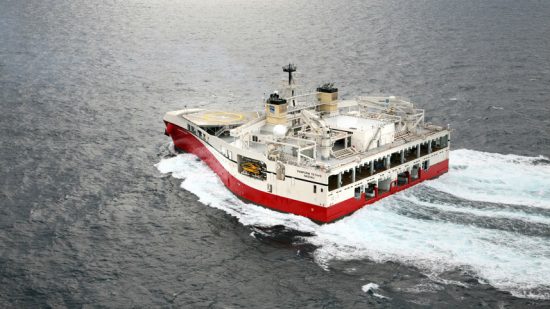
Shuttle Tanker
Shuttle Tanker is a specialized tanker used for oil transportation from the oilfield to the refinery. The technology was first used in 1970s in the North Sea as an alternative to pipeline, but the development of the Dynamic Positioning and further retreating of oil exploration to the sea made Shuttle Tankers the real game changers in 2011 when Petrobras introduced them into their Cascade and Chinook fields operations.
Wind Farm Installation Vessels (WIV)
WIV are robust offshore vessels constructed for transportation and installation of wind turbines. As the majority of offshore vessels, they prove to be very complex structures. For instance, they have to be big enough to carry offshore foundations, manoeuvrable to squeeze through offshore wind farms and possess constructional capabilities to install wind foundations in any weather.
The world’s largest wind farm installation vessel is about to be delivered to Jan De Nul Group. The Voltaire will be 181.78 m long (incl. helideck) and have 60 m in beam. It’s deadweight will reach 21,500 t and the Huisman crane has a max lifting capacity of 3000 t.
The vessel is assigned for the construction of the 3.6GW Dogger Bank Wind Farm. The project is situated 130 km off the Yorkshire coast and is a joint venture between SSE Renewables and Equinor. Once completed in 2023 Dogger Bank will be able to supply 5% of the UK electricity needs.
 Author: Filip Drozda
Author: Filip Drozda
Filip is a maritime professional. He has been working in the shipping industry for 25 years. Mr. Drozda is an expert in crewing for dry cargo and offshore vessels; has a strong technical background, speaks Polish, English and Russian languages.

